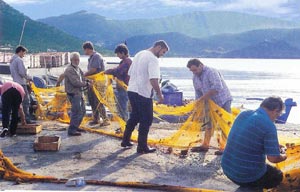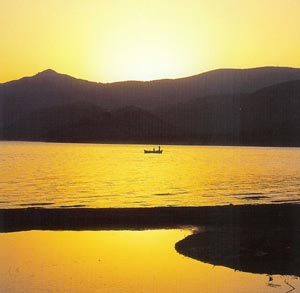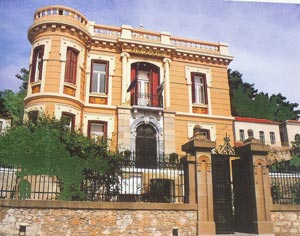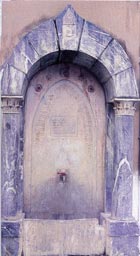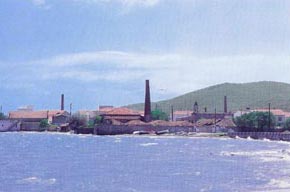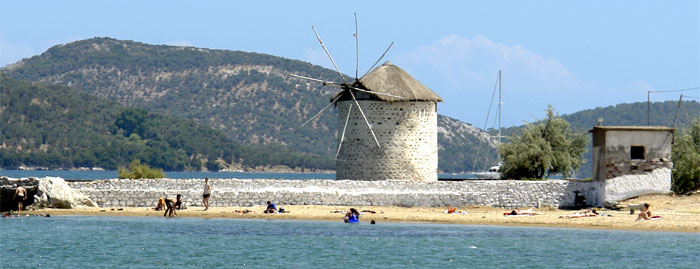Y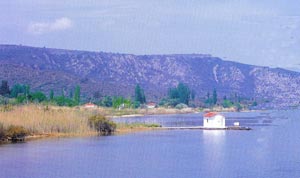 era,
with its five villages overlooking its idyllic gulf, the gulf of
olive grooves, is a splendid area lying at the southeastern border
of Lesvos. A sixth
settlement, Perama, which serves as a harbor to the other five
villages, is laid out on a tree-clad lowland wherein lush orchards
and flowing springs abound: in autumn, the plain is suffused with
the colors of fruit-bearing pomegranates and quince trees, while in
springtime the singing of the midnight nightingale is wafted in the
still of the night. era,
with its five villages overlooking its idyllic gulf, the gulf of
olive grooves, is a splendid area lying at the southeastern border
of Lesvos. A sixth
settlement, Perama, which serves as a harbor to the other five
villages, is laid out on a tree-clad lowland wherein lush orchards
and flowing springs abound: in autumn, the plain is suffused with
the colors of fruit-bearing pomegranates and quince trees, while in
springtime the singing of the midnight nightingale is wafted in the
still of the night.The century-long history of Yera is lost into time. In the course of the Roman era, a coastal town, under the name Yera, was laid out in the area of Halatses, and was eventually devastated by seismotectonic process by the 1st century AD. Archaeological finds come to uphold this historical information. In all probability, following this calamity, settlements were established from the coastal zone of the gulf in the ensuing years. From various historical testimonies, it transpires that Skopelos and Mesagros are the older villages  . .Yera having received influences during the Genoese domination in Lesvos, subsequently came under the rule of Ottoman Turks.
The early years of this period must have been very difficult.
However, a sort of equilibrium was later achieved, allowing for a
peaceful coexistance between the Ottomans and the greek inhabitants
who actually came to prevail in the economic and the social domain
towards the end of the Ottoman occupation. In addition, the greek
Orthodox Church managed to preserve intact and inviolate the
traditions and mores of the Greek culture. Mansions
situated in the villages also come to
denote the prosperity experienced in those days. Wealth,
nevertheless, was concentrated by a restricted number of
individuals, land owners and merchants for the most part,
while the majority of people who toiled in the
fields, in harsh conditions, lived on the poverty line. One should
not be oblivious of
the positive impact exerted on the region by the Greeks of Asia
Minor who after being incorporated to the
population of Yera in the wake of 1922,
gave a considerable boost to the era's development.
The emigrants of Yera have prospered financially and many among them
have excelled in the scientific field. In
recent years, immigration to the greek capital and abroad has
declined and a tendency for repatriation has been largely observed.
The local inhabitants are generally known for their hospitality, wit
and sense of humor, the latter chiming in perfectly with their
vernacular. Although the love for one's birthplace is a commonly
shared feeling among Greeks, it is more intensely experienced by the
people of Yera. Perhaps it is the alluring natural scenery of this
unique place that arouses such a feeling.
Monuments-Buildings
Perama
Since the automobile was an inexistent commodity at the time, those who wished to go to Mytilini boarded, along with their livestock, spacious barges, propelled by oars and sails, and crossed over to Kandouridia and Akoth.
Wholesale stores abounded in
a region of Perama, thus, attracting a great number of people who rode down from
the upper villages on mules, do At the left tip of the harbor, lied the old fish market, the balouhanas, a wooden building supported by wooden piles driven dip into the bottom of the sea. Boats were moored underneath the platform and fish was carried up through a trapdoor in the building's wooden floor. Fishermen woold load their donkeys with crates of fish and set out for the nearby villages, roving through the lanes and pedding their haul.
Today the wooden balouhanas no longer exists. At its site, a
small taverna operates. The vividly painted caiques have given way to ferry
boats, just as donkeys have been replaced by vehicles and the local grocer's
shops have been superseded by supermarkets.
As for the transportation of the
olive oil, it is nowadays pumped into sanitary
tank-trunks. Perama still sustains its charm against a backdrop of beautiful old
buildings. The harbor accommodates today larger ships and the
area grows busier during the peak tourist season, i.e. in the summer. The church of Saint Nikolaou, patron saint of the sailors is dominated by Mt Oros. In winter its peaks are lacerated by thunders and the sea rages. Yet, the Saint watches over seamen sailing in open sea.
Yera Gulf The Gulf of Yera has always been and still is the area'a soul and breath. Today, the life of its inhabitants continues to be inextricably associated with it. Known to the old Aegean seamen as a secure natural shelter for vessels, the bay of Yera functioned as a heaven for the Allied fleet in World War I. Perama, the harbor of Yera, was the area's gateway to the financial worlds of the East and West.
|
